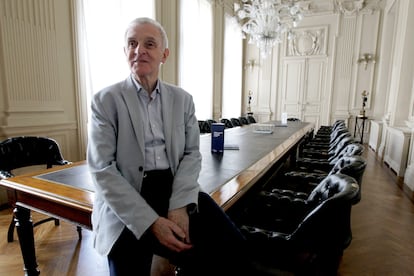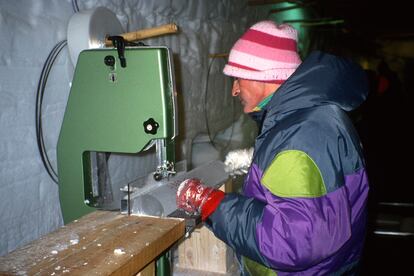It was one of the most epic scientific expeditions of all time. At the end of 1984, in the midst of the Cold War between the atomic powers of the United States and the Soviet Union, an American C-130 plane landed in the most legendary place in Antarctica: the inhospitable Russian Vostok base, installed in the coldest corner of the planet. A year earlier, a record temperature of 1,000 had been recorded there. 89.2 degrees below zeroThe aircraft was carrying three French scientists on board—Claude Lorius, Michel Creseveur and Jean Robert Petit—with an extraordinary mission: to collect ice from time immemorial in order to find out what the Earth’s remote past was like and predict the future of mankind.
Pictures from the time show that in this hostile place vodka flowed, accordions played and the red flag with the hammer and sickle of the Soviet Union waved. The Leningrad Mining Institute had chosen Vostok, near the geomagnetic south pole, as a hellish testing ground for its new drilling technologies, in search of Antarctic oil. The base stank of kerosene from the machinery, which had already managed to make a hole more than two kilometres deep in the ice. Two decades earlier, in 1965, the glaciologist Claude Lorius I had had a revelation while drinking A thousand-year-old whiskey with ice at the French Antarctic base Dumont d’Urville. He looked into his glass and watched the bubbles rising from the ice cubes. What if the trapped air contained information about the atmosphere and climate on Earth thousands of years ago? What if that data revealed the fate of humanity?
Lorius’s obsession since that whiskey was to obtain virgin ice from the depths of Antarctica, so he seduced the Soviets into letting him visit Vostok and convinced the Americans to transport him to the enemy base. The French glaciologist Jean Jouzel He clearly remembers the triumphant arrival of the Antarctic ice samples at his laboratory in Saclay, near Paris, in early 1985. It was a fragmented column of 2,083 metres, which at its oldest end was 1,000 years old. 160,000 years. Jouzel never set foot in Vostok, but he analyzed its entrails and amazed the world. The results of his research, published on the cover of Magazine Nature On October 1, 1987, they were the definitive confirmation that the increase in carbon dioxide (CO₂) in the atmosphere was causing temperatures to rise.
“It was a magnificent adventure, from a human point of view and also from a political point of view. We had meetings with Soviets and Americans, in the middle of the Cold War. The friendship between scientists was key to making it possible,” recalls Jouzel, sitting in a monumental room at the San Nicolás Palace in Bilbao. On June 20, this 77-year-old glaciologist received the BBVA Foundation Frontiers of Knowledge Award — worth 400,000 euros — together with four younger colleagues who followed his path in Antarctica and Greenland, shedding light on the origins of climate change.

The inspiring whisky man, Claude Lorius of the National Centre for Scientific Research (CNRS), passed away in March 2023 at the age of 91, but the Soviet colleague who opened the doors of Vostok to him is still alive: the legendary glaciologist Vladimir Mikhailovich Kotlyakovof the Russian Academy of Sciences. Kotliakov, 92, answers EL PAÍS’s questions in Russian, in email messages written in Cyrillic. “The relations with French scientists over the years were very close and friendly. We did not feel any Cold War,” he says. Kotliakov, a pioneer of Russian polar research, downplays the importance of surviving in the coldest place on the planet. “I visited Soviet bases in the interior of Antarctica and was outdoors at less than 70 degrees below zero, but I must say that, if you are well covered and also do physical exercise, such as digging a hole in the snow with a shovel, you can work even three hours,” he says.
The journey of the thousand-year-old ice from Vostok to Jouzel’s laboratory was an epic one. An American plane transported the samples from the heart of Antarctica to a Soviet ship, which took them to the French coast, where a refrigerated truck transported them to the Commission for Atomic Energy and Alternative Energiesin the Paris region. Jouzel’s team immediately analyzed deuterium, a heavy form of hydrogen that makes up the water molecule. The warmer it is, the more deuterium there is in the snow, with a mathematical ratio that allowed calculate temperatures of the last 160,000 years with precision.

“Our discovery came at an extremely important time,” Jouzel said. Another group of experts, led by American meteorologist Jule Charney, I had already warned In 1979, scientists predicted that doubling atmospheric carbon dioxide would boost global temperatures by as much as three degrees, according to simulations. The Vostok data showed that this was not speculation. The two-kilometer ice column revealed a dance of temperatures over the past 160,000 years, from a low of nine degrees below the 1987 average to a peak of two degrees above. The planet may begin to warm naturally by 1990. a subtle variation in its orbit around the Sun, but this phenomenon is accelerated because, by receiving greater solar radiation, the oceans and the soil release more CO₂ by the decomposition of organic matter. At present, it is humanity itself, with the burning of oil, gas and coalwhich fuels the greenhouse effect. Just one year after the cover of NatureJouzel points out, the United Nations General Assembly supported the creation of the Intergovernmental Panel on Climate Change (IPCC).
The third vice-president of the Spanish Government, Teresa Ribera, knows the French glaciologist well. They worked together between 2014 and 2018 in the Institute for Sustainable Development and International Relationsa think tank based in Paris. Jouzel was the president and Ribera, the directoruntil she returned to Spain to become Minister for Ecological Transition. “Paleoclimate, the study of past climate, is essential to understanding its evolution. The contribution of Jean Jouzel and his colleagues in the 1980s was key to showing the correlation between climate and greenhouse gas concentration,” Ribera celebrates. “Jouzel became a key reference in the first IPCC assessment report, which was decisive in achieving the first multilateral treaty to combat climate change adopted a few years later at the Earth Summit held in Rio de Janeiro in 1992,” applauds the minister.

The hardy Vostok drillers did not stop at 2,083 metres. In January 1998, another hole reached 3,623 metres, a depth sufficient to confirm that CO₂ and methane in the atmosphere were linked to temperature for 420,000 years. “I admire the Soviets. They continued drilling even in winter, with temperatures below 80 degrees below zero. They were formidable,” Jouzel recalls with a nostalgic tone. The French and Russian scientists published their new results in the magazine Nature in 1999, with a warning to humanity: “The current atmospheric concentration of these two important greenhouse gases appears to be unprecedented in the past 420,000 years.”
Jouzel recalls that Madrid welcomed A crucial IPCC meeting on November 27-29, 1995. Delegates from oil-producing countries such as Saudi Arabia and Kuwait fought over every word to water down the panel’s second report and downplay the human impact on the planet’s climate. “It was in Madrid that I proposed introducing the term climate surprise,” recalls the French glaciologist. After their discoveries in the Vostok ice, analyses by Jouzel and his colleagues in Greenland had documented sharp variations in temperature. up to 16 degrees temperature in just a few decades, tens of thousands of years ago.

Latest IPCC reportpublished just over a year ago, warned that the burning of fossil fuels and unsustainable use of energy and land has already caused global warming of 1.1 degrees above pre-industrial levels. That increase has generated more extreme heat waves, torrential
rains, drought and megafires. “We are heading towards a 3-degree increase and, in some regions, it will be very difficult, if not impossible, to adapt. If we do not reduce emissions now, it is a terrible selfishness towards the youngest,” warns Jouzel.
The weather has gone crazy even at Vostok. On March 18, 2022, thermometers at the Russian base recorded an unusual temperature of 17.7 degrees below zero, the highest for that month since records began in 1958. It is a record that spray for 15 degrees the previous maximum was observed in 1967. It is too early to talk about a climate surprise, but humans are also warming the coldest corner of the world.
You can write to us at [email protected] or follow to SUBJECT in Facebook, Twitter, Instagram or subscribe here to our bulletin.
Subscribe to continue reading
Read without limits
_
#mission #coldest #place #world #changed #history #humanity